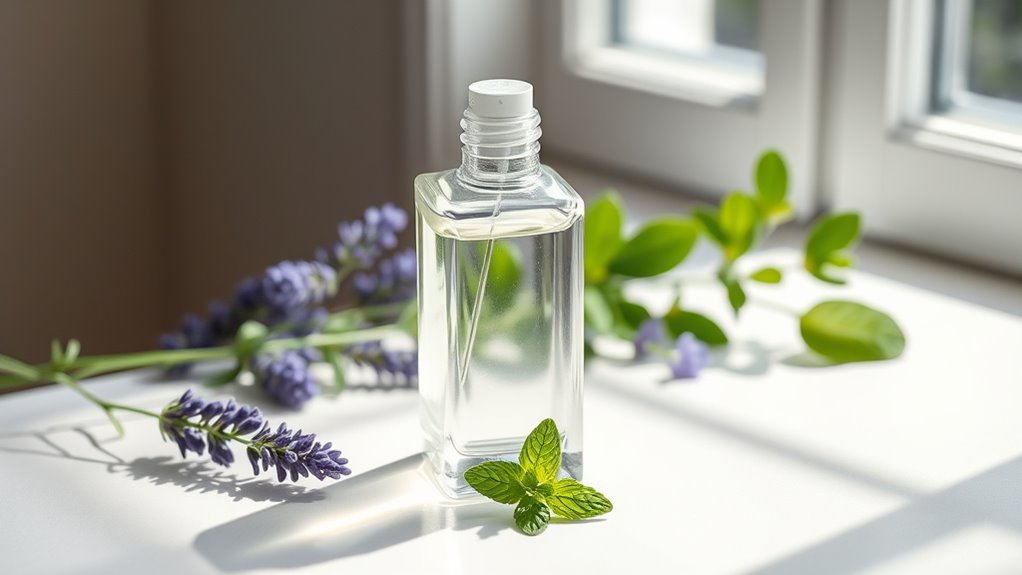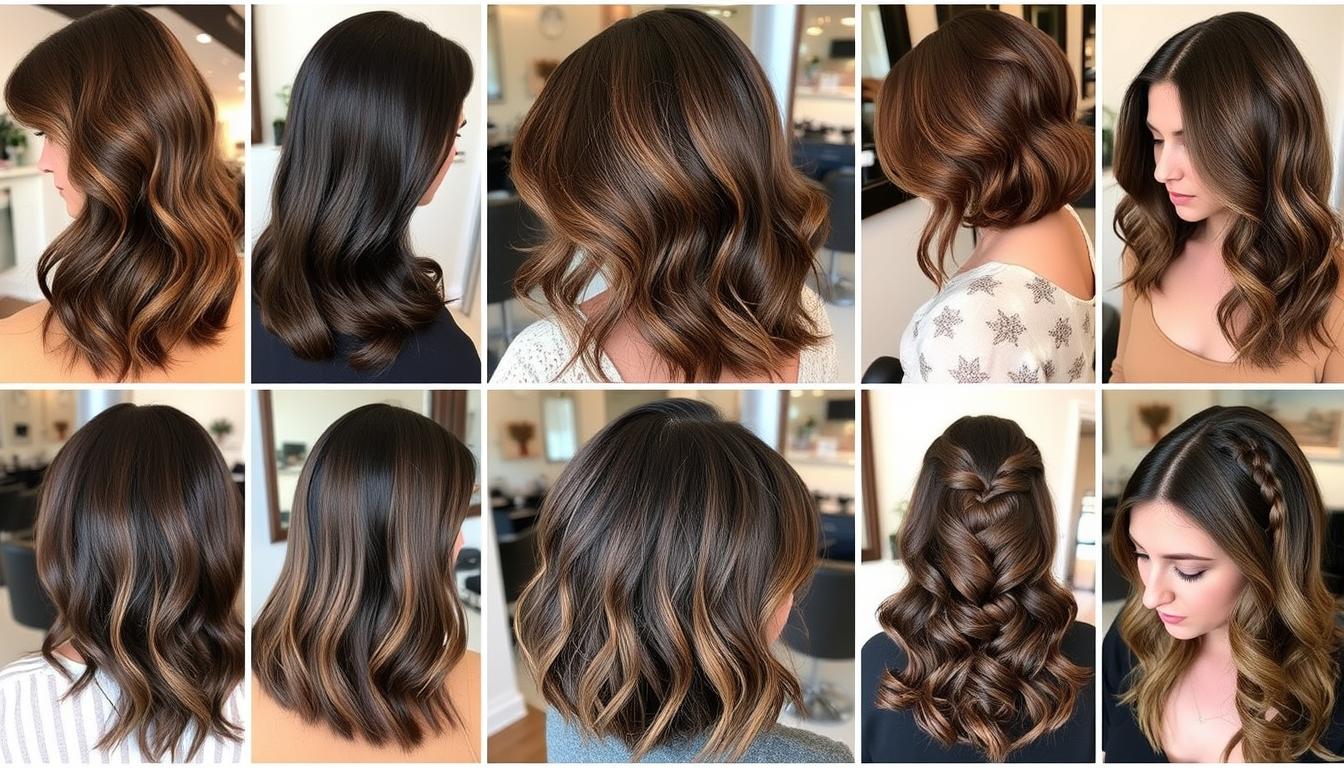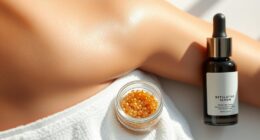To create non-toxic clean fragrances, formulators combine natural plant-based ingredients like herbs and botanical extracts with safe synthetic alternatives that mimic natural scents. This approach guarantees the fragrance is both authentic and stable while avoiding harmful chemicals like phthalates and parabens. By prioritizing transparency and safety, these scents deliver freshness without irritation. If you want to understand more about the unique balance behind clean fragrances, keep exploring what makes them both effective and safe.
Key Takeaways
- Non-toxic scents are formulated using natural ingredients like plant extracts and botanical oils to ensure safety and purity.
- Synthetic alternatives are carefully selected to mimic natural aromas while maintaining non-toxicity and scent stability.
- Formulators avoid harmful chemicals such as phthalates, parabens, and artificial dyes to create safe, clean fragrances.
- Transparency in ingredient listing is prioritized to inform consumers about the natural and synthetic components used.
- The blending process balances natural and synthetic ingredients to produce long-lasting, safe, and authentic scent profiles.

Have you ever wondered what makes a fragrance truly clean? It’s a question many people ask as they seek scents that not only smell good but also align with their health and environmental values. Clean fragrances focus on transparency and purity, often avoiding the traditional chemicals that can cause irritation or harm. At the core of these scents are natural ingredients, which come from plants, herbs, and botanical extracts. These ingredients offer authentic aromas that evoke freshness and simplicity, making them a popular choice for those desiring a non-toxic scent. Natural ingredients are prized because they’re minimally processed and free from synthetic chemicals, giving you peace of mind whenever you wear or use these fragrances.
However, not all natural ingredients are perfect for everyone, and some can be unpredictable in scent consistency or shelf life. That’s where synthetic alternatives come into play. These are lab-created compounds designed to mimic the aromas of natural ingredients but with greater stability, consistency, and affordability. Synthetic alternatives allow formulators to craft clean fragrances that are free from harmful chemicals yet still deliver a robust and appealing scent profile. They can serve as a bridge between authenticity and safety, ensuring that you get a clean fragrance that lasts longer and remains consistent over time.
When you choose a clean fragrance, you’re often selecting products that balance natural ingredients with carefully formulated synthetic alternatives. This combination helps to create a scent that’s both safe and delightful. Many brands now prioritize transparency, listing all ingredients and avoiding phthalates, parabens, and artificial dyes. This means you can enjoy a fresh, clean aroma without exposing yourself to potentially harmful chemicals. It’s about making mindful choices—favoring products that are thoughtfully designed with your health and the environment in mind.
In essence, the art of formulating a clean fragrance involves selecting the right blend of natural ingredients and synthetic alternatives to achieve a scent that’s pure, safe, and pleasing. You benefit from fragrances that are free from toxic substances, yet still evoke the fresh, lively feelings associated with traditional scents. As you explore different brands, look for those that emphasize transparency and use a balanced approach, ensuring that your signature scent aligns with your values. A truly clean fragrance doesn’t just smell good—it makes you feel good, too, by respecting your well-being and the planet.
Frequently Asked Questions
Are Non-Toxic Fragrances Suitable for Sensitive Skin?
Yes, non-toxic fragrances are generally suitable for sensitive skin because they often offer hypoallergenic benefits, reducing the risk of allergic reactions. They are formulated to minimize skin irritation potential, making them a better choice if you have sensitive skin. You’ll likely find these fragrances gentler and less likely to cause redness, itching, or discomfort, helping you enjoy pleasant scents without compromising your skin’s health.
How Long Do Clean Fragrances Typically Last?
You might wonder how long clean fragrances last. Typically, their fragrance longevity ranges from a few hours to half a day, depending on the scent’s formulation and your skin chemistry. Scent durability varies based on ingredients—natural notes tend to fade faster than synthetic ones. To maximize longevity, apply to pulse points and consider layering with matching products. Keep in mind, individual skin chemistry influences how long your fragrance stays vibrant.
Can Non-Toxic Scents Cause Allergies or Headaches?
Like a gentle whisper of a summer breeze, non-toxic scents aim to soothe, but hypoallergenic concerns remain. You might experience allergies or headaches if you’re scent sensitive, despite their all-natural reputation. These fragrances, while designed to reduce irritants, can still trigger reactions in some people. Always test new scents cautiously, especially if you’re prone to scent sensitivity, to make sure they bring comfort, not discomfort.
Are Clean Fragrances More Expensive Than Conventional Ones?
You might notice that clean fragrances often cost more than conventional ones. This pricing comparison mainly stems from ingredient costs, as non-toxic scents use higher-quality, safer ingredients that are often pricier. While the initial investment is higher, you’re choosing a product that’s better for your health and the environment. So, yes, clean fragrances tend to be more expensive, but many find the benefits worth the extra cost.
Do Non-Toxic Fragrances Contain Synthetic Ingredients?
Non-toxic fragrances often avoid synthetic compounds, but some may still contain fragrance molecules created in labs. You might find natural ingredients blended with small amounts of synthetic compounds to enhance scent, though these are carefully selected to guarantee safety. Always check labels to see if fragrance molecules are plant-based or synthetic. In general, non-toxic scents aim to minimize synthetic ingredients, but some formulations use carefully chosen synthetic compounds for better longevity.
Conclusion
So, next time you spritz on that “clean” fragrance, remember it’s not always as pure as it seems. While non-toxic scents aim to keep harmful chemicals out, the irony is that true purity can still be a myth in the perfume world. You might think you’re choosing health, but sometimes, it’s just a clever marketing game. Ultimately, being informed is your best scent—because not every “clean” fragrance is as innocent as it smells.









